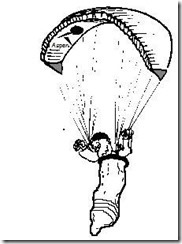“Every landing you walk away from is a good landing”. That’s the mantra we use when we’ve ****ed up the compulsory bit of the flight, telling ourselves it was OK, we survived. But that’s not good enough, is it? Aviation is a serious business and it’s vital to review any part of the flight that went wrong and learn from it. So here’s my tale of a crash that could have had much more serious consequences:
Parlick west bowl, lovely February day, wind strong enough to keep most sensible pilots on the ground well below the west bowl wall. I’d been to Tailbridge, arriving there just late enough to watch a few PGs landing backwards after some stationary moments, so after rushing back to Parlick I was keen to fly. The wind eased a bit, a few of us took off and experienced the usual single-digit groundspeeds you get when the wind is so strong. It was smooth enough but a bit nerve-jangling so after a while, one by one people were going down and landing well below the wall. By the time I got round to penetrating forward far enough to spiral down, the wind had increased significantly. I was still climbing in full speed bar and big ears.
Now, I’m the first to admit that my landing skills aren’t the best, so I planned to make several approaches to get the timing right. Each time I turned towards the hill from 100’ lower than before, getting used to the speed of approach, the rapid climb that happened as soon as I got near the ground, and practised timing the turn across the slope, ready to touch down and kill the wing. Finally, ready to commit, I was down at 900’ AMSL (below the fence at the bottom of the hill) and lined up my approach. . . .
Hurtling over the green grass in the lower field, everything went to plan: as I got near the fence I started to climb and could see I was going to clear the fence easily, so got ready to turn. That’s when the vario stopped its happy sound. I was clear of the wall but now had no room to turn as there was a slight gully. All the brake in the world didn’t get me out of trouble, and I hit the ground. Hard. Legs, backside, bounce, legs again before the world went quiet. All well, no injuries and no damage but I was worried the wind would reinflate my glider and take me for a drag.
So, what happened? As I sat there checking myself over, the weird thing was the wind: there wasn’t any! What little there was blew DOWN the slope, so no dragging danger. I was in rotor. I need to go back and have a look at the ground, but clearly the fence, gentle undulations and hollows down there can create enough turbulence in strong winds to spoil your day. Wind creates turbulence; strong wind and gradient creates more turbulence; close to the ground it gets worse; changes in the terrain amplify this. Close to the ground we are vulnerable.
Lessons? There is no substitute for experience and practising the things we find hard. I was doing the right thing by rehearsing my landing, but failed to realise what could go wrong: the fence was limiting my options and disturbing the airflow – I had to maintain course while climbing in order to clear it, but when I lost height I was in a corner. These days of soaring in winter are ideal for practising the skills of taking off and landing. Not to self: need to do more.
Tight lines
Brian
